Business Accounting and Finance Report - Module Name, Semester Details
VerifiedAdded on 2019/11/26
|8
|1204
|149
Report
AI Summary
This report provides a comprehensive overview of key concepts in business accounting and finance. It begins by addressing the treatment of accumulated depreciation, capitalization, and various inventory methods such as LIFO, FIFO, and specific identification. The report then delves into the analysis of financial reports, including cash flow statements, balance sheets, and revenue statements, emphasizing the importance of cash flow and profit. Ethical issues are explored through a case study of ABC Learning. Furthermore, the report discusses accounting and impression management, including impression management strategies and the use of digital dashboards for data visualization and performance analysis. The report concludes by summarizing key findings and emphasizing the importance of these concepts in the business context.
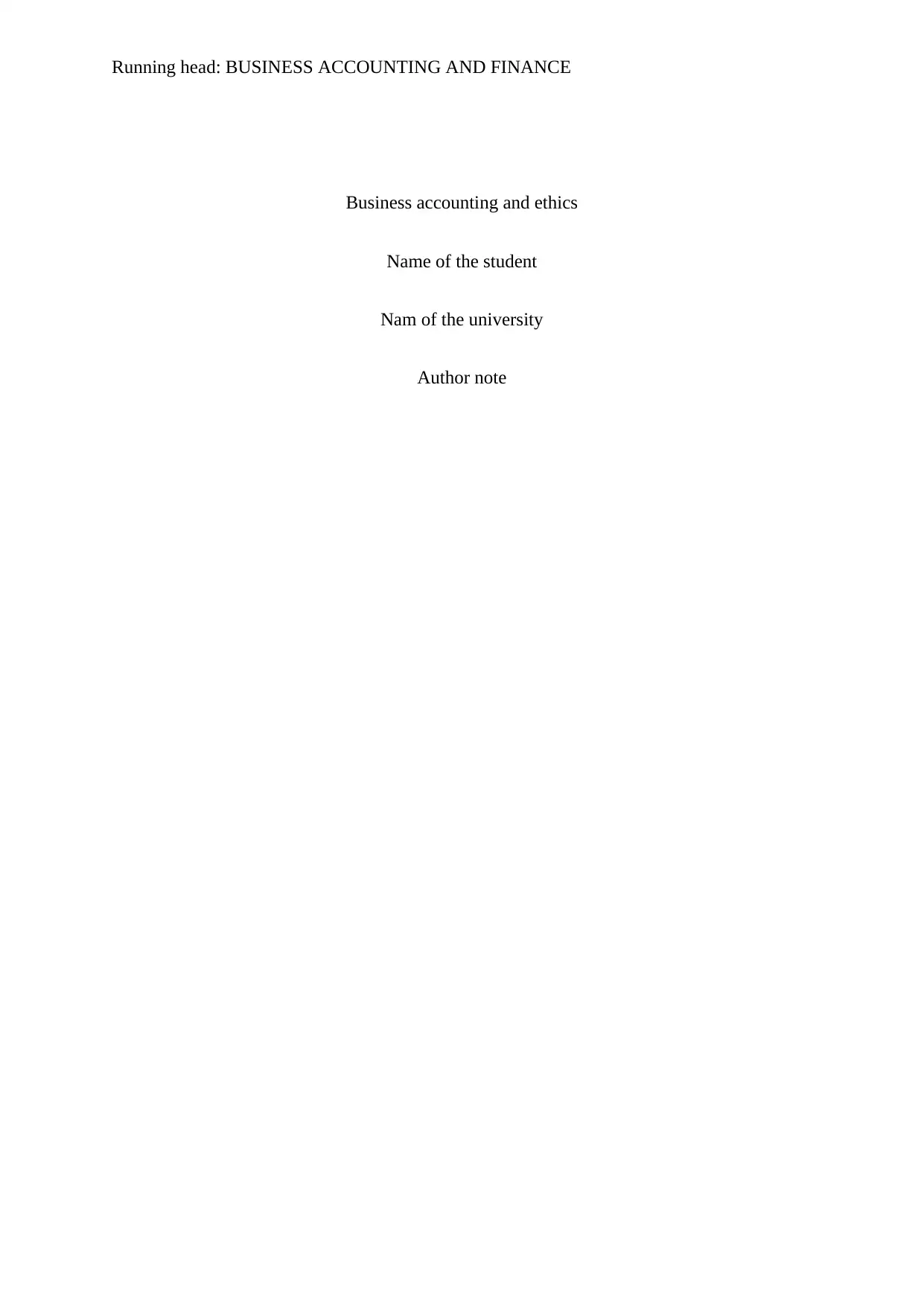
Running head: BUSINESS ACCOUNTING AND FINANCE
Business accounting and ethics
Name of the student
Nam of the university
Author note
Business accounting and ethics
Name of the student
Nam of the university
Author note
Paraphrase This Document
Need a fresh take? Get an instant paraphrase of this document with our AI Paraphraser
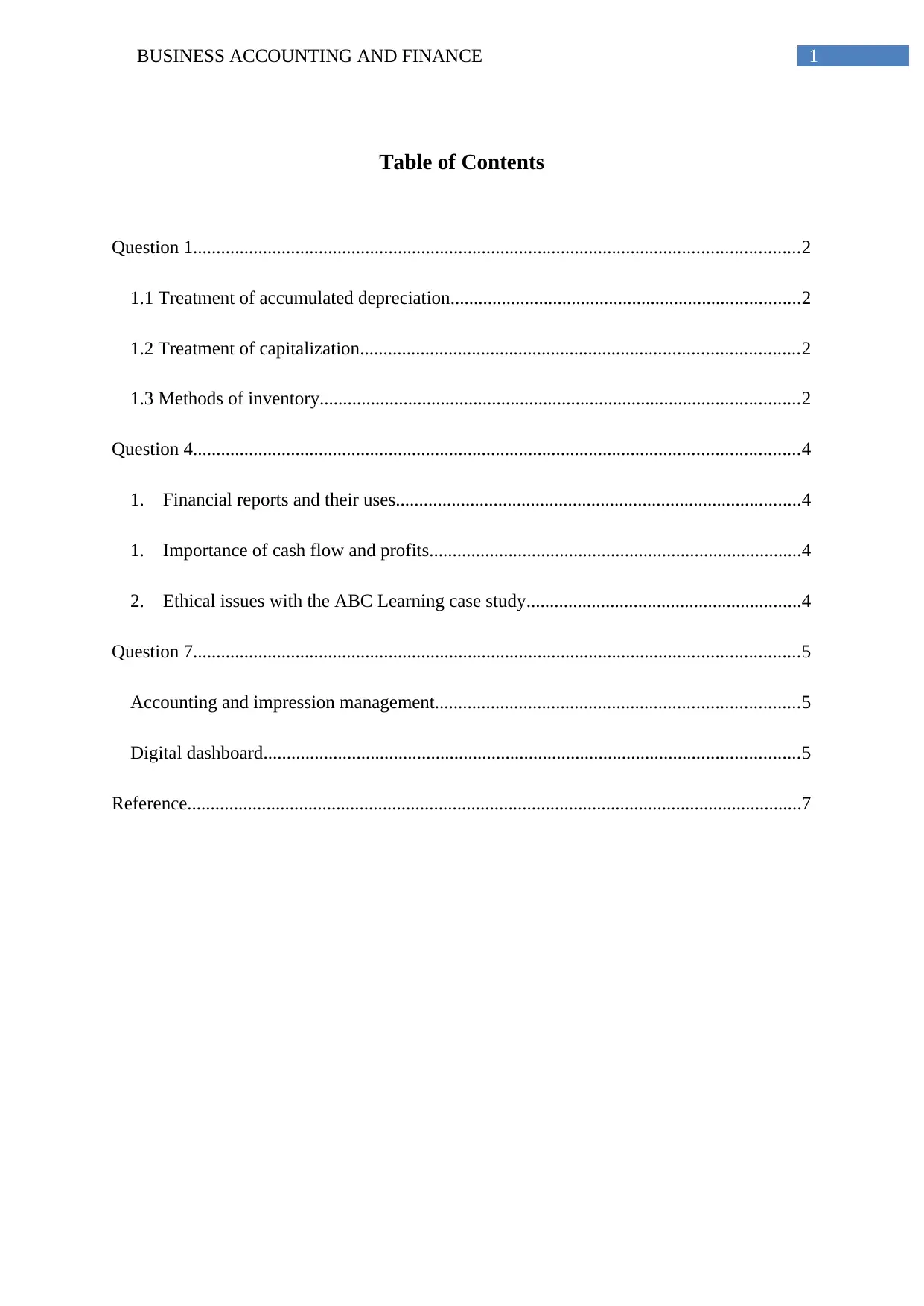
1BUSINESS ACCOUNTING AND FINANCE
Table of Contents
Question 1..................................................................................................................................2
1.1 Treatment of accumulated depreciation...........................................................................2
1.2 Treatment of capitalization..............................................................................................2
1.3 Methods of inventory.......................................................................................................2
Question 4..................................................................................................................................4
1. Financial reports and their uses.......................................................................................4
1. Importance of cash flow and profits................................................................................4
2. Ethical issues with the ABC Learning case study...........................................................4
Question 7..................................................................................................................................5
Accounting and impression management..............................................................................5
Digital dashboard...................................................................................................................5
Reference....................................................................................................................................7
Table of Contents
Question 1..................................................................................................................................2
1.1 Treatment of accumulated depreciation...........................................................................2
1.2 Treatment of capitalization..............................................................................................2
1.3 Methods of inventory.......................................................................................................2
Question 4..................................................................................................................................4
1. Financial reports and their uses.......................................................................................4
1. Importance of cash flow and profits................................................................................4
2. Ethical issues with the ABC Learning case study...........................................................4
Question 7..................................................................................................................................5
Accounting and impression management..............................................................................5
Digital dashboard...................................................................................................................5
Reference....................................................................................................................................7
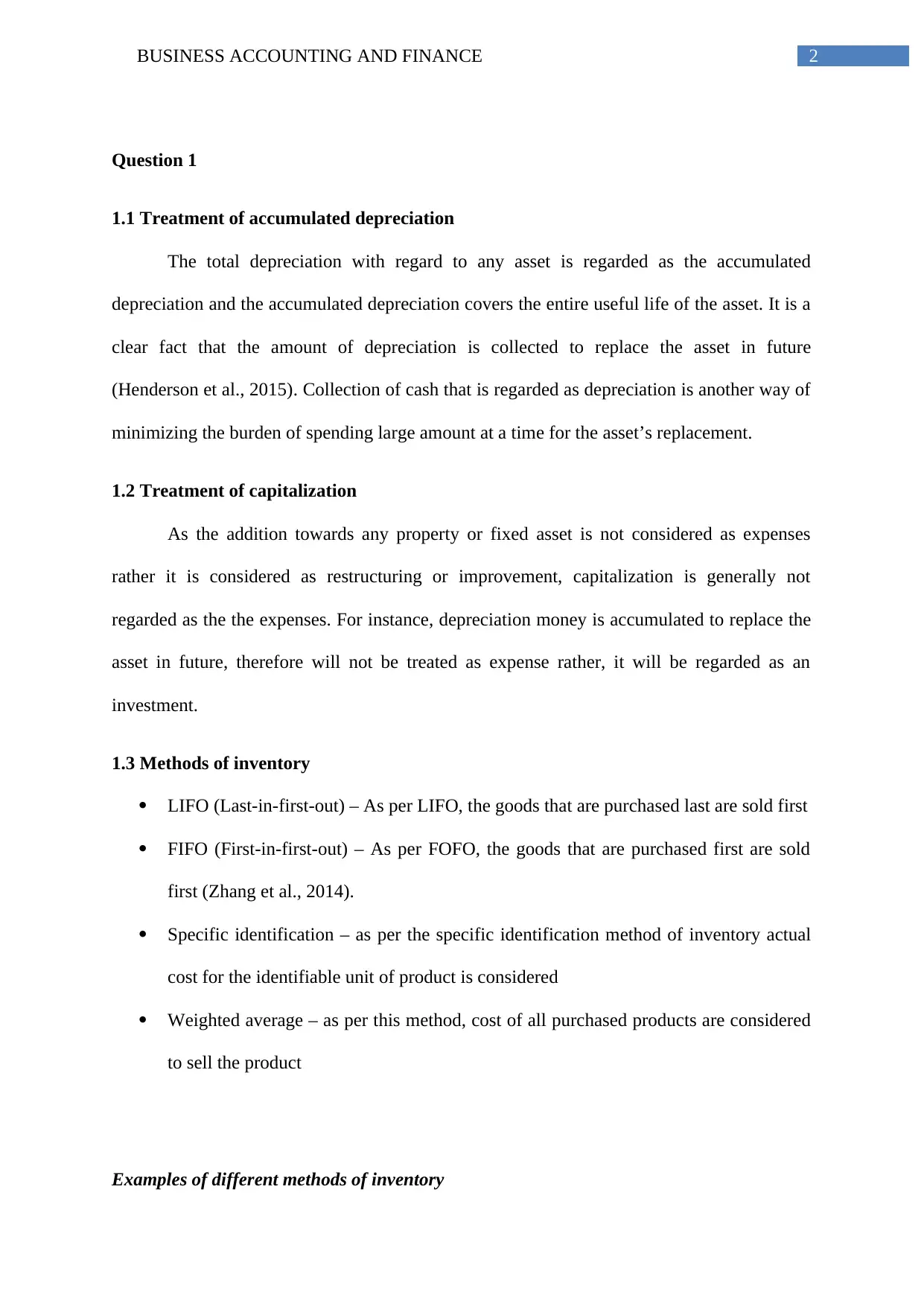
2BUSINESS ACCOUNTING AND FINANCE
Question 1
1.1 Treatment of accumulated depreciation
The total depreciation with regard to any asset is regarded as the accumulated
depreciation and the accumulated depreciation covers the entire useful life of the asset. It is a
clear fact that the amount of depreciation is collected to replace the asset in future
(Henderson et al., 2015). Collection of cash that is regarded as depreciation is another way of
minimizing the burden of spending large amount at a time for the asset’s replacement.
1.2 Treatment of capitalization
As the addition towards any property or fixed asset is not considered as expenses
rather it is considered as restructuring or improvement, capitalization is generally not
regarded as the the expenses. For instance, depreciation money is accumulated to replace the
asset in future, therefore will not be treated as expense rather, it will be regarded as an
investment.
1.3 Methods of inventory
LIFO (Last-in-first-out) – As per LIFO, the goods that are purchased last are sold first
FIFO (First-in-first-out) – As per FOFO, the goods that are purchased first are sold
first (Zhang et al., 2014).
Specific identification – as per the specific identification method of inventory actual
cost for the identifiable unit of product is considered
Weighted average – as per this method, cost of all purchased products are considered
to sell the product
Examples of different methods of inventory
Question 1
1.1 Treatment of accumulated depreciation
The total depreciation with regard to any asset is regarded as the accumulated
depreciation and the accumulated depreciation covers the entire useful life of the asset. It is a
clear fact that the amount of depreciation is collected to replace the asset in future
(Henderson et al., 2015). Collection of cash that is regarded as depreciation is another way of
minimizing the burden of spending large amount at a time for the asset’s replacement.
1.2 Treatment of capitalization
As the addition towards any property or fixed asset is not considered as expenses
rather it is considered as restructuring or improvement, capitalization is generally not
regarded as the the expenses. For instance, depreciation money is accumulated to replace the
asset in future, therefore will not be treated as expense rather, it will be regarded as an
investment.
1.3 Methods of inventory
LIFO (Last-in-first-out) – As per LIFO, the goods that are purchased last are sold first
FIFO (First-in-first-out) – As per FOFO, the goods that are purchased first are sold
first (Zhang et al., 2014).
Specific identification – as per the specific identification method of inventory actual
cost for the identifiable unit of product is considered
Weighted average – as per this method, cost of all purchased products are considered
to sell the product
Examples of different methods of inventory
⊘ This is a preview!⊘
Do you want full access?
Subscribe today to unlock all pages.

Trusted by 1+ million students worldwide
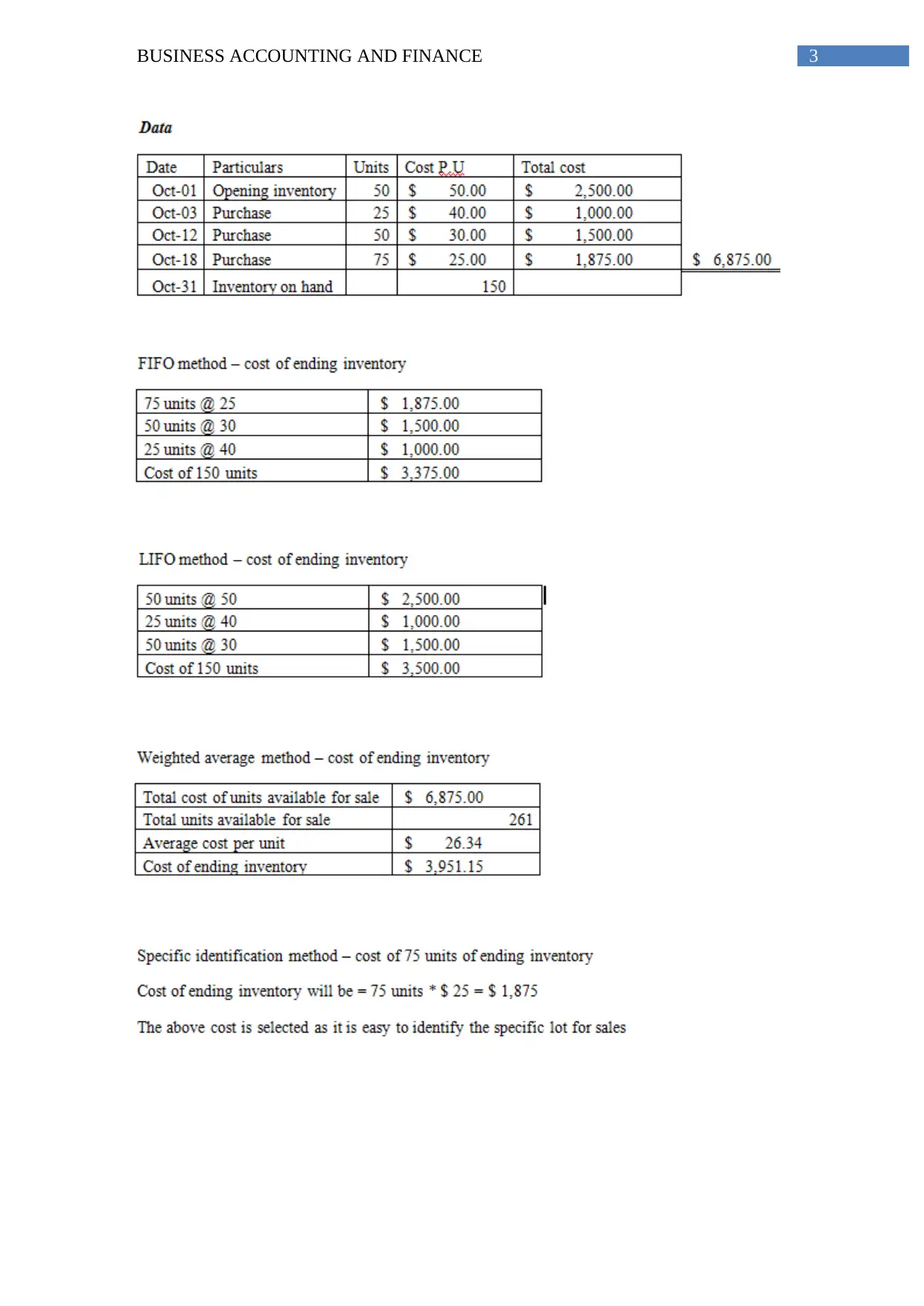
3BUSINESS ACCOUNTING AND FINANCE
Paraphrase This Document
Need a fresh take? Get an instant paraphrase of this document with our AI Paraphraser
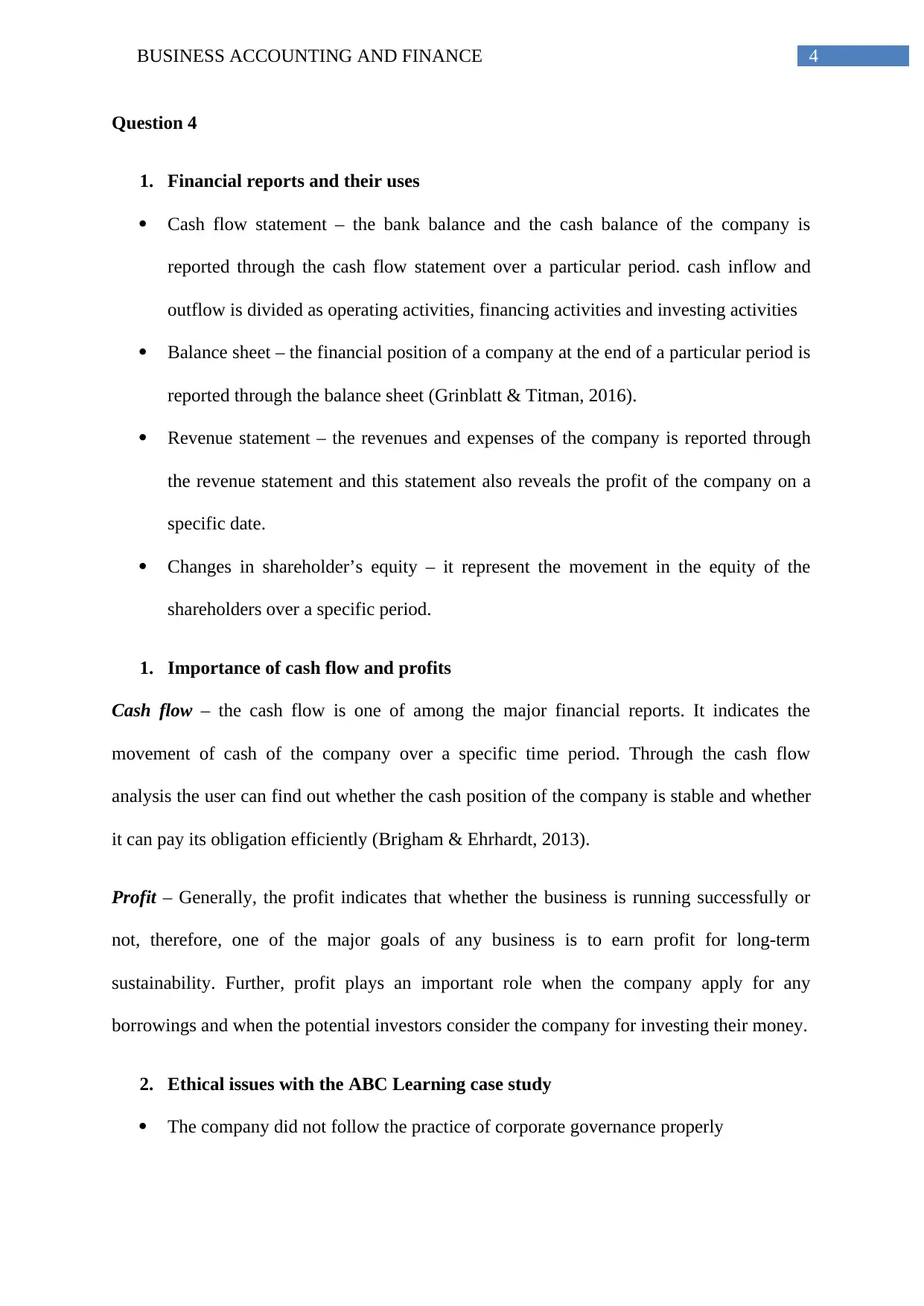
4BUSINESS ACCOUNTING AND FINANCE
Question 4
1. Financial reports and their uses
Cash flow statement – the bank balance and the cash balance of the company is
reported through the cash flow statement over a particular period. cash inflow and
outflow is divided as operating activities, financing activities and investing activities
Balance sheet – the financial position of a company at the end of a particular period is
reported through the balance sheet (Grinblatt & Titman, 2016).
Revenue statement – the revenues and expenses of the company is reported through
the revenue statement and this statement also reveals the profit of the company on a
specific date.
Changes in shareholder’s equity – it represent the movement in the equity of the
shareholders over a specific period.
1. Importance of cash flow and profits
Cash flow – the cash flow is one of among the major financial reports. It indicates the
movement of cash of the company over a specific time period. Through the cash flow
analysis the user can find out whether the cash position of the company is stable and whether
it can pay its obligation efficiently (Brigham & Ehrhardt, 2013).
Profit – Generally, the profit indicates that whether the business is running successfully or
not, therefore, one of the major goals of any business is to earn profit for long-term
sustainability. Further, profit plays an important role when the company apply for any
borrowings and when the potential investors consider the company for investing their money.
2. Ethical issues with the ABC Learning case study
The company did not follow the practice of corporate governance properly
Question 4
1. Financial reports and their uses
Cash flow statement – the bank balance and the cash balance of the company is
reported through the cash flow statement over a particular period. cash inflow and
outflow is divided as operating activities, financing activities and investing activities
Balance sheet – the financial position of a company at the end of a particular period is
reported through the balance sheet (Grinblatt & Titman, 2016).
Revenue statement – the revenues and expenses of the company is reported through
the revenue statement and this statement also reveals the profit of the company on a
specific date.
Changes in shareholder’s equity – it represent the movement in the equity of the
shareholders over a specific period.
1. Importance of cash flow and profits
Cash flow – the cash flow is one of among the major financial reports. It indicates the
movement of cash of the company over a specific time period. Through the cash flow
analysis the user can find out whether the cash position of the company is stable and whether
it can pay its obligation efficiently (Brigham & Ehrhardt, 2013).
Profit – Generally, the profit indicates that whether the business is running successfully or
not, therefore, one of the major goals of any business is to earn profit for long-term
sustainability. Further, profit plays an important role when the company apply for any
borrowings and when the potential investors consider the company for investing their money.
2. Ethical issues with the ABC Learning case study
The company did not follow the practice of corporate governance properly
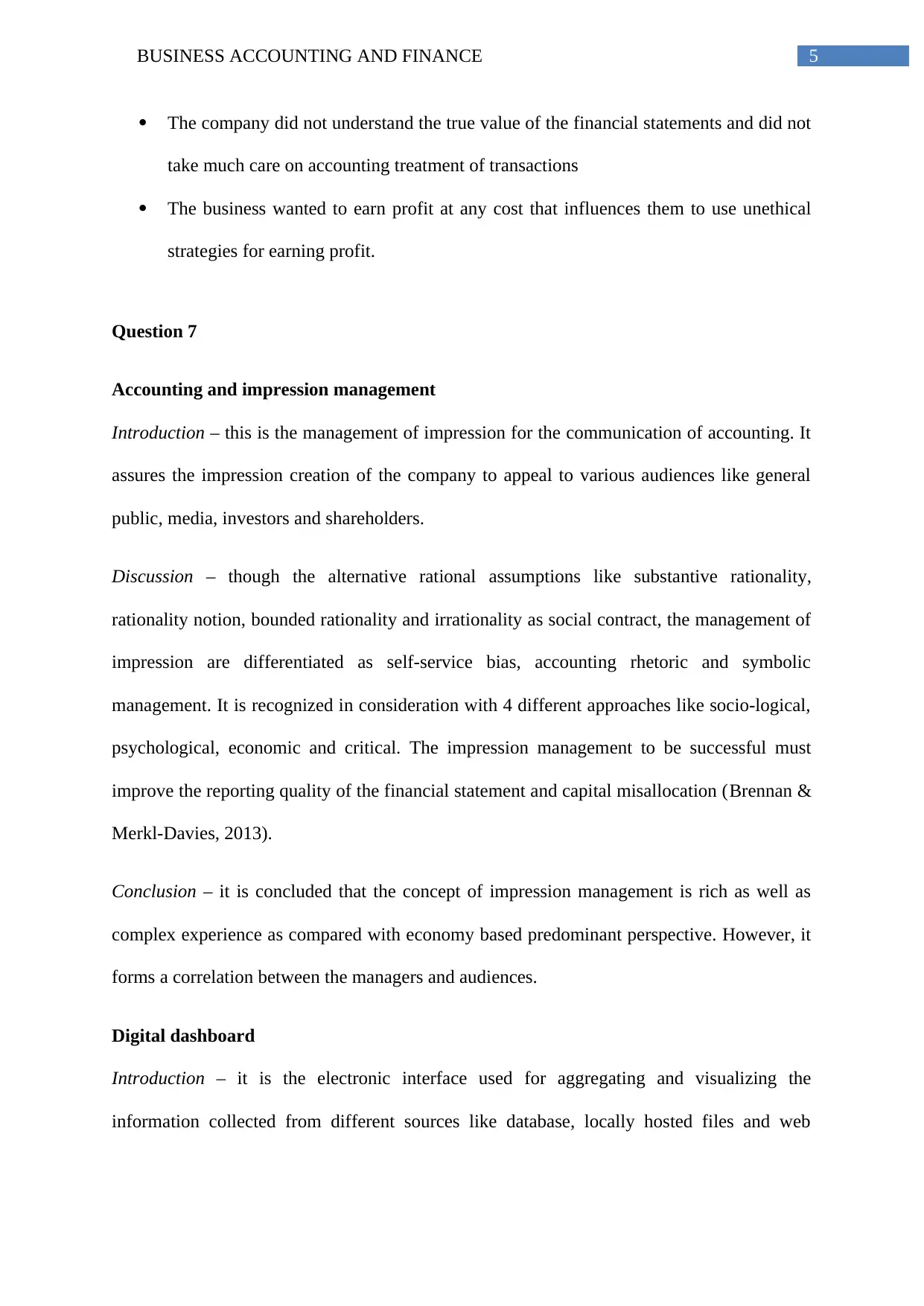
5BUSINESS ACCOUNTING AND FINANCE
The company did not understand the true value of the financial statements and did not
take much care on accounting treatment of transactions
The business wanted to earn profit at any cost that influences them to use unethical
strategies for earning profit.
Question 7
Accounting and impression management
Introduction – this is the management of impression for the communication of accounting. It
assures the impression creation of the company to appeal to various audiences like general
public, media, investors and shareholders.
Discussion – though the alternative rational assumptions like substantive rationality,
rationality notion, bounded rationality and irrationality as social contract, the management of
impression are differentiated as self-service bias, accounting rhetoric and symbolic
management. It is recognized in consideration with 4 different approaches like socio-logical,
psychological, economic and critical. The impression management to be successful must
improve the reporting quality of the financial statement and capital misallocation (Brennan &
Merkl-Davies, 2013).
Conclusion – it is concluded that the concept of impression management is rich as well as
complex experience as compared with economy based predominant perspective. However, it
forms a correlation between the managers and audiences.
Digital dashboard
Introduction – it is the electronic interface used for aggregating and visualizing the
information collected from different sources like database, locally hosted files and web
The company did not understand the true value of the financial statements and did not
take much care on accounting treatment of transactions
The business wanted to earn profit at any cost that influences them to use unethical
strategies for earning profit.
Question 7
Accounting and impression management
Introduction – this is the management of impression for the communication of accounting. It
assures the impression creation of the company to appeal to various audiences like general
public, media, investors and shareholders.
Discussion – though the alternative rational assumptions like substantive rationality,
rationality notion, bounded rationality and irrationality as social contract, the management of
impression are differentiated as self-service bias, accounting rhetoric and symbolic
management. It is recognized in consideration with 4 different approaches like socio-logical,
psychological, economic and critical. The impression management to be successful must
improve the reporting quality of the financial statement and capital misallocation (Brennan &
Merkl-Davies, 2013).
Conclusion – it is concluded that the concept of impression management is rich as well as
complex experience as compared with economy based predominant perspective. However, it
forms a correlation between the managers and audiences.
Digital dashboard
Introduction – it is the electronic interface used for aggregating and visualizing the
information collected from different sources like database, locally hosted files and web
⊘ This is a preview!⊘
Do you want full access?
Subscribe today to unlock all pages.

Trusted by 1+ million students worldwide
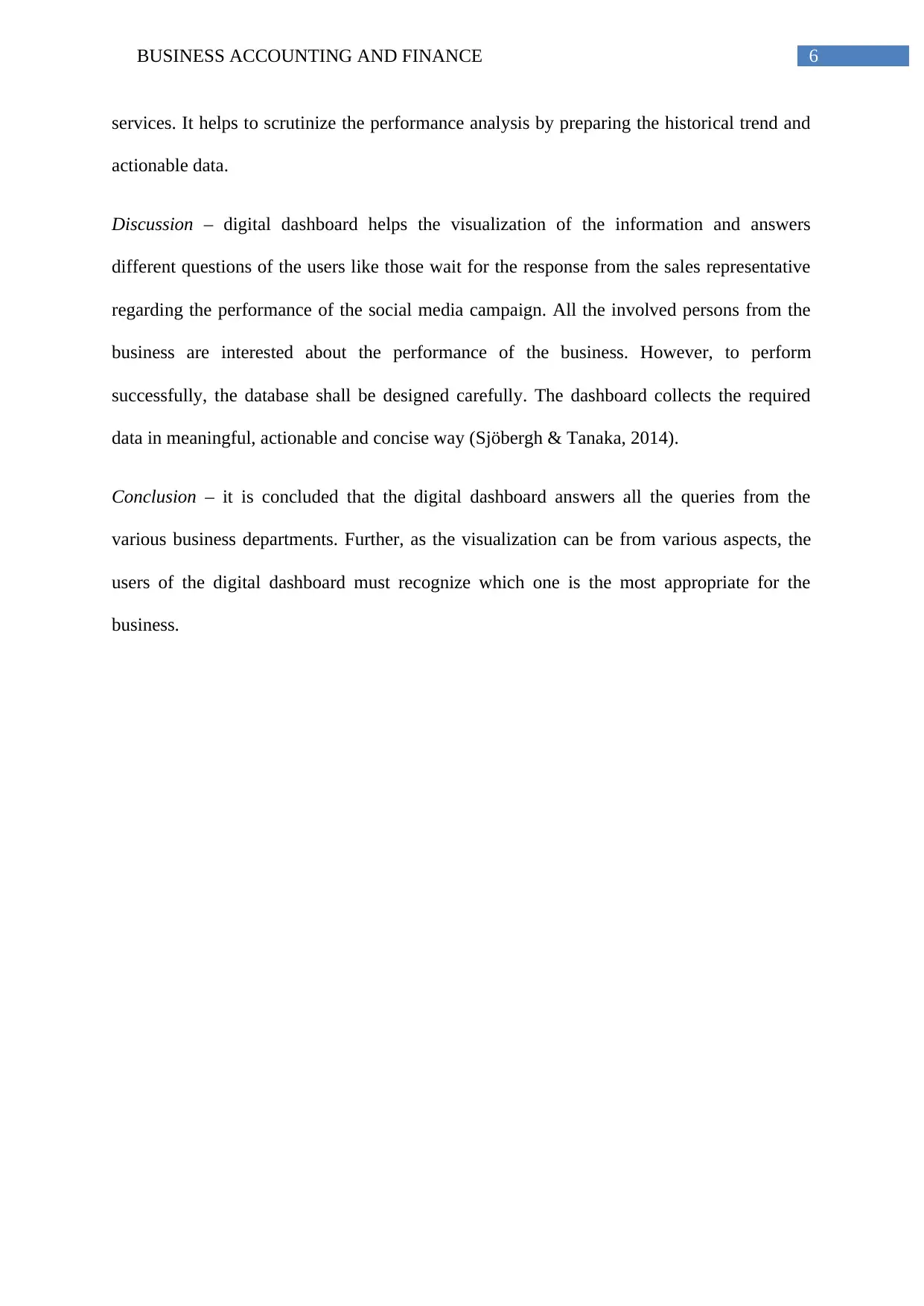
6BUSINESS ACCOUNTING AND FINANCE
services. It helps to scrutinize the performance analysis by preparing the historical trend and
actionable data.
Discussion – digital dashboard helps the visualization of the information and answers
different questions of the users like those wait for the response from the sales representative
regarding the performance of the social media campaign. All the involved persons from the
business are interested about the performance of the business. However, to perform
successfully, the database shall be designed carefully. The dashboard collects the required
data in meaningful, actionable and concise way (Sjöbergh & Tanaka, 2014).
Conclusion – it is concluded that the digital dashboard answers all the queries from the
various business departments. Further, as the visualization can be from various aspects, the
users of the digital dashboard must recognize which one is the most appropriate for the
business.
services. It helps to scrutinize the performance analysis by preparing the historical trend and
actionable data.
Discussion – digital dashboard helps the visualization of the information and answers
different questions of the users like those wait for the response from the sales representative
regarding the performance of the social media campaign. All the involved persons from the
business are interested about the performance of the business. However, to perform
successfully, the database shall be designed carefully. The dashboard collects the required
data in meaningful, actionable and concise way (Sjöbergh & Tanaka, 2014).
Conclusion – it is concluded that the digital dashboard answers all the queries from the
various business departments. Further, as the visualization can be from various aspects, the
users of the digital dashboard must recognize which one is the most appropriate for the
business.
Paraphrase This Document
Need a fresh take? Get an instant paraphrase of this document with our AI Paraphraser
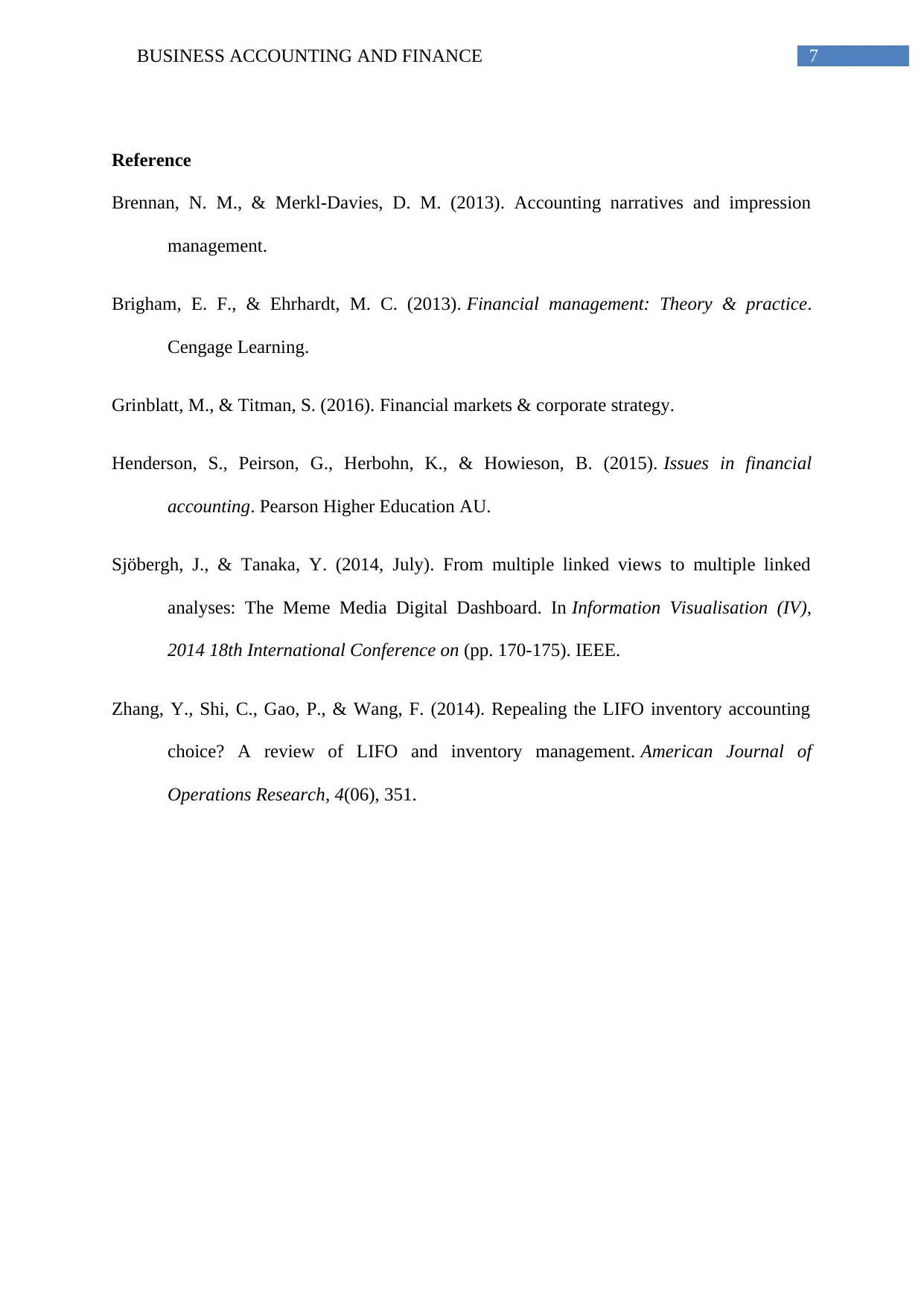
7BUSINESS ACCOUNTING AND FINANCE
Reference
Brennan, N. M., & Merkl-Davies, D. M. (2013). Accounting narratives and impression
management.
Brigham, E. F., & Ehrhardt, M. C. (2013). Financial management: Theory & practice.
Cengage Learning.
Grinblatt, M., & Titman, S. (2016). Financial markets & corporate strategy.
Henderson, S., Peirson, G., Herbohn, K., & Howieson, B. (2015). Issues in financial
accounting. Pearson Higher Education AU.
Sjöbergh, J., & Tanaka, Y. (2014, July). From multiple linked views to multiple linked
analyses: The Meme Media Digital Dashboard. In Information Visualisation (IV),
2014 18th International Conference on (pp. 170-175). IEEE.
Zhang, Y., Shi, C., Gao, P., & Wang, F. (2014). Repealing the LIFO inventory accounting
choice? A review of LIFO and inventory management. American Journal of
Operations Research, 4(06), 351.
Reference
Brennan, N. M., & Merkl-Davies, D. M. (2013). Accounting narratives and impression
management.
Brigham, E. F., & Ehrhardt, M. C. (2013). Financial management: Theory & practice.
Cengage Learning.
Grinblatt, M., & Titman, S. (2016). Financial markets & corporate strategy.
Henderson, S., Peirson, G., Herbohn, K., & Howieson, B. (2015). Issues in financial
accounting. Pearson Higher Education AU.
Sjöbergh, J., & Tanaka, Y. (2014, July). From multiple linked views to multiple linked
analyses: The Meme Media Digital Dashboard. In Information Visualisation (IV),
2014 18th International Conference on (pp. 170-175). IEEE.
Zhang, Y., Shi, C., Gao, P., & Wang, F. (2014). Repealing the LIFO inventory accounting
choice? A review of LIFO and inventory management. American Journal of
Operations Research, 4(06), 351.
1 out of 8
Related Documents
Your All-in-One AI-Powered Toolkit for Academic Success.
+13062052269
info@desklib.com
Available 24*7 on WhatsApp / Email
![[object Object]](/_next/static/media/star-bottom.7253800d.svg)
Unlock your academic potential
Copyright © 2020–2025 A2Z Services. All Rights Reserved. Developed and managed by ZUCOL.





